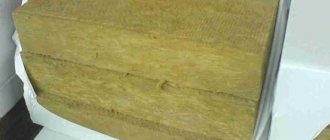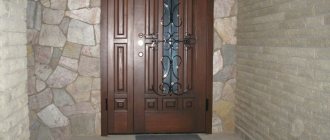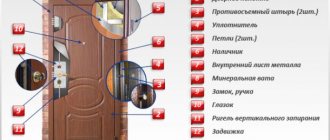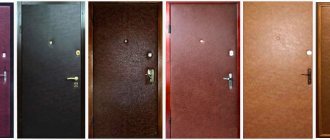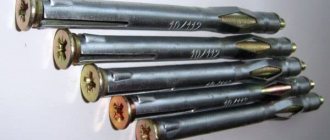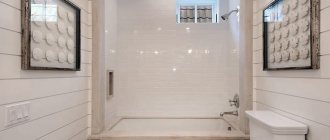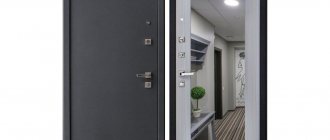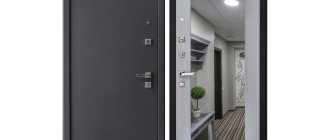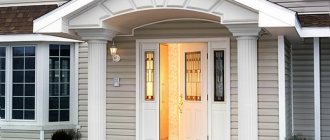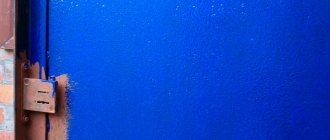Reasons for heat loss in a home, the need to insulate the entrance metal door. The choice of materials for thermal insulation, features of internal and external insulation. Elimination of gaps and thermal protection of the door frame. The nuances of insulating a steel door with a split structure, common insulation errors and ways to solve them.
An entrance door made of metal has many advantages. It serves for a long time, has high strength and reliably protects the home from outside penetration. Despite all its qualities, a metal structure will not make your home warmer, which is why owners of residential premises often have to solve thermal insulation issues on their own. How to insulate a metal entrance door and choose the right materials for thermal protection - further in the article.
What causes heat loss?
A modern metal entrance door is actually a complex structure, where iron is just a shell. The cavities of the leaf can be filled with insulation, since the main function of the door is to retain heat. But there are often heat leaks, not only in private houses, but also in apartments. In addition, inexpensive metal doors have ordinary tin as a body, and cardboard honeycomb instead of insulation.
Reasons for heat loss in the house:
- Thin walls. Walls built in the classical way several decades ago, which do not have insulation, begin to freeze over time. As a result, the thermal insulation of the house deteriorates.
- Cracks and crevices. When a heavy structure shrinks, cracks form on the walls, which over time, if you do not pay attention to them, turn into huge gaps. Such gaps are also called cold bridges.
- Technical openings (old doors and windows). Over time, the wood dries out, thereby forming colossal gaps where the boxes are installed. Windows that are not properly insulated are one of the key sources of heat loss. And a door, if it is made of sheet metal and does not have the necessary insulation, or is of poor quality Chinese construction, with cardboard inside instead of a heat insulator, this is the direct cause of colossal heat loss.
A metal door that does not have proper insulation is a direct source of cold in the house.
Therefore, door insulation is an important component of the thermal protection of the entire house. But before you implement your idea, find out the exact reasons for the loss of heat, so that you don’t end up wasting time and energy on insulating the doors, and the reason for the uncomfortable microclimate lies in the cold bridges formed through the cracks in the house.
Important! The thickness of the iron door leaf is not an indicator of the thermal insulation of the door. A thick layer of metal is, first of all, protection against penetrations and only then a heat insulator (provided that there are no cracks in the structure).
Sometimes heat can be lost not through the leaf, but through the cracks of the iron door frame
Plastic
Installation of insulation is carried out similarly to wooden structures. A plastic door, which is covered with dermantine on top, will provide good protection from the cold. Only here it is necessary to replace the nails with construction glue. The process goes like this:
- remove the door;
- remove the fittings;
- install insulation;
- lubricate the structure and all elements, and then install the handles back;
- decorate the surface according to personal discretion.
Choosing insulation
The insulation on the door not only protects the room from the cold, but also insulates the rooms from extraneous noise, which is quite important in apartment buildings. Therefore, when choosing a ready-made door structure, you should inquire about its contents.
Penofol
Penofol is equipped with a foil layer with reflectivity, thanks to which all the heat remains indoors. But, as a rule, it is used only as an auxiliary insulating material.
Rigid (sheet) insulation
Sheet heat insulators (penoplex, polystyrene foam, etc.) are easy to install and low in cost. Since the material is not hygroscopic, it is not necessary to attach a vapor barrier and moisture-proof membrane when installing it.
When choosing rigid insulation, give preference to expanded polystyrene (penoplex). It is much denser and stronger than polystyrene foam, and also insulates more effectively.
Soft (rolled) insulation materials
Rolled or sheet soft thermal insulators include glass wool and mineral wool. They differ only in the base; their thermal insulation characteristics are approximately the same. The material is environmentally friendly, non-flammable, and allows you to independently choose the installation height, eliminating additional trimming. These advantages make cotton insulation especially popular.
Illustrative examples of heat loss
The material is sold in rolls or slabs. Elements of any shape and size can be cut out of rolled wool, and to reduce the thickness of the insulating layer, simply press and fix the material.
The disadvantage of cotton wool is its high hygroscopicity. The material is afraid of moisture and if the insulation absorbs water, it loses its heat-protective properties. Experts do not recommend using this insulation for doors, since with a high contrast of external and internal temperatures, the likelihood of the insulation getting wet is extremely high. However, the option is quite acceptable for the entrance door to an apartment.
Inflatable (sprayed) insulation
Polyurethane foam fills all the cracks without being particularly expensive. You can spray it yourself, using a foam gun or inviting the help of a specialist using a special sprayer.
Luxury entrance doors
doors are insulated with three types of heat insulators:
- key insulation – polystyrene foam;
- penofol is an auxiliary protection;
- The cavities of the door frame and stiffeners are filled with polyurethane foam
In construction markets you can often see insulation kits for entrance doors. The insulation and finishing material have already been measured and cut according to the standard, but such sets are of little use, since they include thin-layer padding polyester or foam rubber and leatherette.
Step-by-step instructions for insulation
A high-quality door leaf reliably protects the room from loss of warm air. We offer instructions on how to easily insulate a wooden entrance door with your own hands.
Required tools and materials
For the work you will need the following tools:
- screwdriver;
- roulette;
- mounting gun;
- stapler, staples;
- hammer;
- decorative and construction nails;
- scissors, pencil;
- router or grinder with cutter.
Materials you will need:
- insulation - better polystyrene foam, polystyrene;
- seal;
- upholstery material (leatherette).
Preparatory work
Before starting work, check the door for any existing cracks. To do this, you can use a lighter. Where there are cracks, the light will tremble from the draft. In such a place you need to put marks.
It is better to place the door leaf on the floor. Remove old upholstery. Remove the handles. Next, measure the height and width of the product.
From the outside, the canvas is measured from edge to edge. When measuring the inside, it is recommended to deviate from the edges by 2-3 cm.
Door upholstery with leatherette
The base of leatherette consists of cotton fabric. On top there is a nitrocellulose coating. Using this material you can transform any door leaf.
Main advantages:
- long service life - up to 15 years;
- moisture resistance;
- resistance to temperature fluctuations.
Leatherette is resistant to rotting processes. The structure resists the growth of bacteria. It is not subject to destruction when exposed to ultraviolet rays, does not fade under the sun, so it is excellent for decorating the front door.
To upholster the structure, you will need a piece of leatherette that exceeds the total area by 15 cm on all sides. Nail upholstery nails on top of pre-positioned foam. The excess is removed, from which rollers are subsequently formed. You can decorate the surface using wire and nails.
Insulation with foam plastic or polystyrene
These materials are the most successful because they retain heat well. Let's look at how to insulate a wooden door with polystyrene foam or polystyrene.
The prepared sheets are cut with a knife, based on the size of the area between the bars, which are laid on the corners. Gaps and joints are filled with polyurethane foam. When the foam hardens, it is cut with a knife to the height of the bars.
Seal installation
The installation procedure looks like this:
- determine the size of existing cracks;
- cut the seal;
- if the tape is self-adhesive, then it is attached along the borders of the door frame;
- silicone is mounted with a stapler.
In this case, it is worth paying attention to the thickness - if it is insufficient, cold air will pass through. Too much thickness prevents the sash from closing.
Tools and materials
In addition to insulation - the main material, you also need fasteners, cladding, etc.
Polymer seal for entrance door
Table 1. All necessary materials and tools
| Materials | Tool |
| Any selected insulation | Mounting tape |
| Polyurethane foam | Square |
| Hardware, liquid nails or polyurethane foam (for installing rigid insulation) | Pencil |
| Wood-based sheet materials or lining (for covering a non-removable door) | Long ruler or rule |
| Scotch tape, hydro- and vapor barrier membrane (in the case of using soft insulation) | Jigsaw or saw |
| Dermantin, MDF or plastic (as a decorative finish) | Screwdriver |
| Rubber or silicone polymer seal | Spatula and container for putty mixture |
| Universal assembly adhesive (has good ability to adhere to surfaces of different textures) | Foam gun |
| Putty for insulating door frames | Stapler |
| Staples or furniture nails | Hammer |
| Dry wood beams for making the internal frame of the door leaf in case of its absence | Construction knife |
Prices for popular models of screwdrivers
Screwdrivers
Important! If glass wool is chosen as the main insulation, do not forget to take care of protecting the skin of your hands, eyes and breathing organs by using glasses, gloves and a respirator. When working with the material, dangerous microparticles (fiber fragments) are released, which, penetrating into the respiratory tract, can cause long-term irritation of organs.
Video - A simple process of insulating a non-removable Chinese door
Stages of plating an iron model
The sequence of actions when covering an old door depends on its design. If the design is more modern and the metal panels are attached to the base with screws, the insulation is done internally. When starting internal insulation, we remove the metal structure and place it on a work surface. Unscrew the screws and remove the metal panel (to ensure that the screws unscrew well, lubricate them with machine oil). Using a tape measure, take the dimensions of the internal cells of the door.
Carefully measure the insulation material and cut it off. Be sure to cut out a place for the door lock and peephole. For old doors, polystyrene foam or foil-lined stone wool are great. We treat the inner surface of the old structure with glue (liquid nails) and glue the prepared insulation. If there are any gaps between the old door and the insulation, fill them with foam. You must work carefully, squeezing out the mounting foam in small portions. It is important to ensure that it does not get on the bolt lock mechanism. For additional sound insulation, we lay foil insulation between the insulation and the metal sheet. We cover the structure with a metal sheet and screw in the screws.
If the old door is made by fixing metal panels by welding, then we proceed to insulate the old door using the external method. We prepare wooden blocks 20 (30) x 20 mm. We measure the parameters and cut the slats to the required length. Using a drill, we make holes for future fastening in the metal sheet. We assemble the base from prepared wooden blocks and fasten it to a metal sheet with self-tapping screws.
We prepare insulation according to the specified dimensions. We line and glue the insulation into the cells between the slats. We fix the MDF panel or board with screws. Additionally, for sound insulation, the door can be treated with leatherette from the outside or inside. To do this, we bend the leatherette and fix it with staples. Lubricate the lining and hem of the leatherette with glue (liquid nails) and press firmly against the metal sheet. This work is painstaking. At the last stage, we install door locks, handles, and a peephole. We return the finished door to its place.
When covering a single-layer metal door, it is necessary to measure the cells between the stiffeners. We cut the inner material to the specified size. We quickly glue the insulation into the cavity. We eliminate cracks and small gaps using polyurethane foam. We decorate with MDF panel.
We insulate the door frame
The frame of the metal door leaf is made from an iron angle, which is secured in the opening with anchors. After removing the old door structure, large gaps often remain between the mounted door frame and the load-bearing wall or partition. When installing, builders blow them with polyurethane foam, but it has a certain drawback: the material is afraid of sunlight. If sections of the foam are not protected from ultraviolet radiation in time, it will crumble into dust over time.
If the foam on any surface turns yellow or brown, the material is beginning to deteriorate.
The old deteriorating foam from the box must be removed and insulated again
How to do it correctly:
- We clean the wall adjacent to the doorway from the remnants of the polyurethane foam, spread the plaster down to the brick or concrete and remove the dust.
- Spray the surface with plain water and foam the visible indentations. The foam will stick better to the wetted wall.
- When the material hardens, cut off the excess.
Prices for polyurethane sealant
Polyurethane sealant
After this, plaster and paint or whitewash can be applied around the box.
Insulation of the door frame
Insulation of a metal entrance door should begin with the elements of the frame. If the box is made from a corner, then insulation is possible only in the places where the box adjoins the doorway. In this case, the gaps are filled with foam, and the excess insulation is cut off with a construction knife. If the box is made of a rectangular or square pipe, the insulation is placed inside the profile.
The better to insulate
To insulate the door frame, use foam or bulk insulation (sawdust, expanded clay).
Polyurethane foam is used to eliminate gaps between the frame and the doorway, as well as to fill the cavities of frame elements made from profiles.
Bulk insulation is used only for profiled frames. The profile is filled through a technological hole drilled in the upper part of the box. The diameter of the hole should allow the largest fractions of filler to pass through.
This method has a significant drawback: it is impossible to ensure that the entire internal space of the box is filled with bulk materials. As a result of uneven filling, voids are formed that freeze. Therefore, the use of bulk insulation is possible only in production conditions, when assembling the box in the workshop.
Materials and tools
To insulate the box you will need the following tools and materials:
- electric drill;
- metal drills with a diameter equal to the diameter of the nozzle of a cylinder with polyurethane foam;
- polyurethane foam;
- construction knife.
Insulation instructions
To fill the door frame with foam, you will need to prepare technological holes with a pitch of 500 mm. Through these holes, the internal space of the profile is filled with polyurethane foam. Excess foam coming out through the holes must be removed with a construction knife.
The gaps between the door frame and the doorway are cleaned of old insulation, moistened and filled with polyurethane foam. Excess foam is removed using a construction knife, after which the contact point between the box and the wall is masked with putty.
We insulate the door leaf
Before insulating an iron door, the structure must be disassembled. To do this, remove the peephole, door handles, locks and linings.
Before insulation, the iron door must be prepared by dismantling all unnecessary
When the canvas is completely prepared, do not forget to wipe it from dirt and dust before starting work.
Step-by-step algorithm for door insulation
Table 2. We insulate the door
| Steps, description | Photo |
| Step 1. If the canvas does not have additional stiffeners creating an internal frame, the skeleton must be assembled from wooden slats. The frame is attached around the perimeter of the door and along the crossbars using self-tapping screws. It is important to choose the thickness of the beams so that they are not wider than the protruding elements of the door leaf. |
|
| Step 2. We put insulation between the frame beams in the resulting cells. Consider the characteristics of the material and the need for additional membrane insulators. |
|
| Step 3. You can attach the insulation with glue directly to the door or directly to the bars. The most reliable fastening will be provided by combining both methods. We lubricate the door leaf with adhesive, apply insulation to it and press it tightly. If the insulation fits tightly into the frame cell, it means that it will be securely fixed in place. |
|
When the glue dries, do not forget to check the door for cold bridges. the gaps formed between the insulation and the frame with foam, not forgetting to cut it off after hardening.
When insulating a metal door, it is important to cut the insulating material in such a way that the gaps between the heat insulator and the frame elements are minimal or completely absent
Prices for mineral wool
Minvata
Nuances of external insulation
A factory or homemade metal door is insulated along the leaf located from the inside of the room. The same insulation materials are used. Protection against heat loss is carried out using two methods:
- Thermal protection using a frame on slats. After dismantling the fittings, the slats are fixed to the canvas using self-tapping screws or a metal profile is mounted by welding. The resulting frame is filled from the inside with thermal insulation, attached with glue. Fiberboard, previously cut to the required dimensions, is fixed on top of the resulting structure.
- A less labor-intensive option is lining with thermal insulating material. To carry out the work, the canvas is removed, cleaned and coated with glue on its surface, and a layer of insulation is laid. Thermal protection is masked using upholstery fabric secured along the outer perimeter.
Clearance seal and door interior trim
Decorating the front door from the inside performs several functions. This is protection of insulation from mechanical influences and other damage, additional heat and noise insulation, as well as a decorative component.
An example of a metal entrance door trimmed with clapboard after insulation
There are a number of requirements for the interior decoration of the door leaf:
- strength,
- moisture resistance,
- durability,
- density,
- external attractiveness.
In most cases, a metal door is sheathed from the inside with laminated chipboard or MDF, plastic or lining, wood or metal, plywood or OSB in combination with leather or dermantine.
External view of the interior decoration of a metal door with plywood and dermantine
Let's consider the algorithm for the internal design of an insulated iron door using the example of using solid sheet materials:
- We cut out a fragment from the sheet to the size of the perimeter of the door leaf frame. It is important that the material does not protrude beyond the sheathing.
- We cut out holes for the peephole, handles and lock secrets in the resulting fragment.
- If you plan to additionally cover the sheet with leather or dermantine, then it is recommended to first upholster the sheet, and then attach it to the door. It is more convenient to carry out upholstery work when the base is in a horizontal position.
- We cut out a solid piece of leather fabric to the size of the base, adding 10 cm on each side.
- We bend the allowances inward and thus attach the material to the base using a stapler. In addition, you can secure the leather with beautiful furniture nails.
- When attaching the fabric to the base, it is important to stretch it well so that unsightly folds do not form. For additional thermal insulation, a small layer of foam rubber or synthetic padding can be placed under the skin. It will also fill the void between the skin and the base and add more appeal to the design.
- When the plywood fragment is completely formed, we coat the door frame with universal glue, apply the plywood to it and fasten it with self-tapping screws with decorative heads (it is important that the self-tapping heads are harmoniously combined with furniture nails).
- We install door handles, locks, peepholes and plugs.
Insulated metal door, covered with plastic after insulation
The final stage is the installation of a polymer seal to prevent drafts from penetrating through the cracks around the perimeter of the door. To do this, the surface of the door leaf and frame is degreased, the protection from the adhesive layer of the seal is carefully removed, the material is applied to the door and pressed. It is important to be careful when installing the seal, as the material is very thin and requires patience during installation.
Video - A budget way to insulate a cheap Chinese door
Closing gaps
If the insulation work carried out does not help to avoid heat leakage, it is necessary to increase the tightness of all joints. Conventional polyurethane foam will help to insulate the cracks in the wall-frame gap. The remaining excess after hardening of the material is cut off to the level with the box. You can prevent the destruction of insulation and extend its service life by applying a layer of plaster over the sealant or installing platbands. In addition to polyurethane foam, rubber or silicone-based sealant is also used to seal seams.
The place of increased heat loss is the area where the sash is adjacent to the frame. When not pressed tightly, a draft appears. The problem can be solved by installing a sealing tape with a self-adhesive layer, available in different cross-sections. For small gaps, material with an oval/round cross-section is suitable. It is better to eliminate gaps larger than 3 mm using tape with a P-shaped section.
The procedure for installing the seal along the door contour is as follows:
- The old sealant is removed (if any), the surface is cleaned and degreased with a solvent.
- The sealing tape is glued along the perimeter of the canvas with an indentation of 3 mm from the outer edge. The material should be pressed well to avoid unevenness.
When installing the seal, the tape should not be too tight, otherwise it will simply come off later. Using tape that is too thick can cause problems with opening/closing doors.
Features of insulation of a metal split door
The algorithm for insulating a metal split door is not much different from the process of thermal insulation of a conventional iron door leaf. The design feature of the door plays a key role here.
Sectional view of a metal split door
The door is removed from its hinges, laid on a horizontal surface, all functional and decorative elements in the form of a peephole, handles, locks and plugs are dismantled, then the internal lining is dismantled (if the product is not monolithic, then the trim is attached with self-tapping screws). In the case of insulation of a non-removable door, the inner lining can be carefully cut with a grinder. When the product is disassembled, cardboard is removed from the cavities and the door is cleaned of any remaining debris and dust.
If there are stiffeners inside the door leaf, drill holes in them at a short distance from each other and fill the voids with foam.
Next, a water barrier is installed, the insulation is cut and attached (remember that some materials do not require moisture protection). The insulation process itself is as simple as in the example with a one-piece door.
The overlay is installed in place. If it becomes unusable after dismantling, the interior design of the door can be replaced. Then the peephole, locks and handles are put in place and the product is installed in the box.
In order not to spoil the integrity of a non-removable Chinese door, it is insulated over the skin
In the case of a monolithic door, if there is no particular desire to spoil its integrity, you can insulate it on top of the existing casing. To do this, a lathing made of timber is attached to the demonstrated and disassembled door leaf from the inside and outside. All further actions are practically no different from the previous algorithms.
How to insulate a door frame?
Many people think that to insulate a metal entrance door it is enough to insulate only the leaf. But in fact, the box also needs insulation. If it is made of a metal corner, then insulation can be done only along the perimeter where it adjoins the opening. To do this, just blow out all the cracks with foam. When the substance hardens, the excess can be cut off with a knife.
In the case when the box is made of a square or round pipe, then insulation can be placed inside it.
Suitable for these purposes:
- Polyurethane foam. It is convenient to seal the gaps between the wall and the frame, as well as fill all the cavities of the door frame.
- Bulk materials. This could be expanded clay, sawdust. To do this, make a hole in the profile and fill it with filler. If you perform this procedure yourself, then not all voids can be filled with material. Thorough insulation is only possible when the box is manufactured in a factory.
But you can try to do the insulation yourself. To do this, you will need a drill and suitable metal drills, the insulation itself (spray foam), and a knife.
Completing of the work:
- Holes are made every 50 cm.
- Using them, the cavity inside the box is filled with foam.
- All of its excess that has emerged through the holes is cut off with a knife.
- The gaps between the opening and the box are also filled with foam.
- When the substance becomes hard, it is cut and puttied.
Internal and external insulation of a metal door will reliably protect the room not only from thieves, but also from frost. You can carry out insulation work on your own by placing suitable material on the outside or inside of the sash. You should also take care of insulating the box and gluing the seal. Only a set of measures will prevent heat loss.
Things to consider
In addition to the thermal insulation of the door leaf itself, the process of door insulation includes other important nuances.
For a better fit of the door leaf to the steel frame, use rubber seals
Polymer sealing tape will help improve the quality of thermal protection of the door. This material is supplied in rolls and sold by the meter. Installing the tape is extremely simple: the seal has an adhesive edge, which attaches it to the door and frame.
Important! Before gluing the tape, do not forget to degrease the surface for better adhesion of the material to the surface.
If the design of the door frame allows, the seal can be glued in several layers
Insulating the doorway itself with polyurethane foam is also very effective. This can be done even if the cavities show no signs of material degradation. Blowing out the voids with foam and then plastering the wall will not be difficult, but will significantly increase the efficiency of insulation.
Also consider the weight of the structure. The weight of a metal door is quite large, and if you add additional insulation and cladding to it, the hinges may not withstand it
The thickness of the door insulated from the outside, as a rule, increases. Take this fact into account when installing locks: they may need to be replaced with designs with extended keys.
The slopes of the metal entrance door also need insulation
Another source of heat loss is indoor door slopes. If they are not completed or sewn up “in a hurry,” they should be given attention. Remove the old finish and fill the cavities with foam. If the space is large enough, fill it with other insulation and secure the trim.
Prices for entrance doors
Entrance doors
Working with slopes
It happens that if installed incorrectly, frost regularly appears on the slopes of the front door. In such a situation, it is worth removing the slopes and installing them again.
Insulation of entrance door slopes
First, the surface of the walls is cleaned, primed and the cracks are filled with putty. If the slopes are damaged, replace them with pieces of drywall of a suitable size, and strengthen the corners with paint corners. In general, insulating a metal door is not difficult to do with your own hands: at minimal cost, the result will definitely please the owners and will become obvious in the near future.
Common Mistakes
Anyone can stumble: both an experienced installer and a novice home craftsman. When insulating a metal entrance door, there are a number of common mistakes that are most often made.
It is better to insulate a metal door that can be easily opened with a can opener without disassembling it, on top of the inner lining
What to watch out for:
- Season. During the cold period, it is better to postpone door insulation until later, even if there is a very warm entrance or dressing room.
- Ignoring details. The gaps between the frame and the material during insulation, the door frame and slopes also need thermal protection, just like the canvas. If you only insulate the door, the room will not become much warmer.
- Saving. When using natural insulation, you should not ignore membrane films, because otherwise the cotton wool will get wet and become useless. In addition, wet insulation will significantly increase the weight of the door, which can lead to deformation of the fasteners.
A metal door insulated in accordance with all the rules, in addition to providing armor against evildoers, will also reliably protect the house from extraneous noise and pervasive cold. In addition, insulation protects the canvas itself from corrosion and, accordingly, increases its service life. Use the materials that are available to you and don’t be afraid to make mistakes, because only those who do nothing make no mistakes.
Some models of metal entrance doors are already insulated from the factory
Note! If your door has already used up its lifespan, instead of insulation, you should think about a modern solution in the form of a door with a thermal break.
Advice from professionals
The following recommendations from experienced craftsmen will help you avoid common mistakes when insulating a wooden front door:
It is more effective to use heat-insulating material on both sides. You should choose consumable components from trusted manufacturers. The selected material must have high performance characteristics. The outer cladding must be resistant to precipitation. Each stage must be treated with full responsibility. In the video on how to insulate a door with leatherette with your own hands, you can get acquainted with some of the features of the work:
Cutting and laying insulation
The next stage of insulating the door leaf will be laying material that will make it warmer . To do this, you need to arm yourself with a stationery knife. Thermal insulation is cut to the length and width of the sheet so that there is no empty space left. If the door is a frame with voids, then they need to be filled with insulation.
The insulation is tightly inserted between the bars
All pieces must be tightly inserted between the bars to prevent the formation of cold bridges. At the same time, the material should not bubble, which would indicate an excessively large supply. In this case, it is worth cutting off a little excess material. Once everything is adjusted, you need to secure the insulation with staples. A construction stapler allows you to do this quickly and efficiently.
Why does heat pass through the door?
It happens that the canvas has high-quality insulation, but for some reason the heat leaves the room. What is the reason? Common causes of heat leakage include:
- Presence of cracks in the canvas. These defects may appear due to inaccuracies during the installation of the structure, subsidence of the structure, or, for example, such unfavorable factors as sudden temperature changes, etc. Sealing compounds or putty will help solve the problem.
- Insufficient fit of the front door to the frame. This is associated with deformation of the canvas or damaged loops. Replacing elements or adjusting the dimensions of the door will help correct the situation.
- Large space between the threshold and the bottom of the canvas. This situation can be changed by replacing the worn threshold with a new one.
Another possible reason is the insufficient thermal insulation properties of corrugated cardboard or other thermal insulation material. Sheathing, upholstery or the construction of a vestibule will help to cope with the problem.
How to avoid freezing your front door
If a consumer purchases a new entrance door, he should take care of its thermal insulation properties in advance. To do this, you need to take into account the following nuances when purchasing a product at a retail outlet, as well as during installation:
- The canvas must be straight, free from defects and bends that will affect the presence of cracks in the future.
- For installation, you should invite professionals with specialized tools who guarantee the results of their work.
Entrance door installation by professionals
- You should purchase products only from well-known manufacturers who have been supplying their products to the domestic market for a long time and have many positive reviews from satisfied customers.
- When choosing frames and handles for doors, you should buy products that have a thermal break with plastic inserts, which significantly reduces the risk of cold transfer.
Door profile with thermal break
Most well-known manufacturers conduct multi-stage testing of their products before launching into mass production.
Door handle with thermal break
Each test is carried out by external laboratories with a certificate of conformity, which indicates the characteristics of the canvas, box and other elements of the enclosing structure.
Door after insulation in the interior
Beautiful ideas
The appearance of the front door always emphasizes the status of the owner. Therefore, in a private home the requirements are especially high. Here it is important to take care of a decent image. The market for metal doors is saturated with a variety of products. Another good thing is that doors can be ordered according to a personal project.
And yet, how nice it is to work on the design yourself! We offer several ideas for decorating metal doors with your own hands. The design of a door in an apartment is interesting because the outside can be decorated so as not to attract other people's attention. The simplest, most affordable way is to decorate a metal door with bright fittings. You can attach new numbers to the outside, add stylized handles, hinges, and locks.
For those who prefer natural materials, we can recommend covering the inside of the door with MDF panels or simple wooden slats. The design and color of the metal door of a private house, as well as the shape, depend on the style in which the house or cottage is built. For fittings, you can use forged parts, stained glass windows, glass inclusions. And instead of a modern bell, you can hang a knocker or gong.
Improving the characteristics of Chinese products
The Chinese-made door is a non-demountable structure. To insulate it, remove the door and place it horizontally. We remove the handles, peephole, locks. Then we begin to attach the frame and stiffeners to it, both from the inside and from the outside. Therefore, we choose a wooden beam with a thickness of 20 * 20 mm, or more (we start from the thickness of the insulation material). If desired, you can weld a metal base, attach it with self-tapping screws or weld it to the door leaf, and fill the joints with polyurethane foam.
The next step is laying insulation. If fibrous materials are selected (mineral wool, stone wool), we lay out a water-repellent material larger in size than the base cavities, approximately 200 mm, secure with glue (liquid nails) and line the wool, having previously cut out a canvas slightly larger than the size of the base cells, and cover with another layer of water-repellent material. We fold the edges of the film tightly onto the top layer and secure with tape.
We cover the insulation with foil isolon or penofol with the foil side facing the room. This will improve the soundproofing qualities of the door. Polystyrene foam, expanded polystyrene, polystyrene, foil-coated isolon do not need waterproofing, since they themselves have water-repellent properties. Next, use a tape measure to measure the distance between the stiffeners, cut the insulation a little larger than necessary to avoid the formation of a cavity between the insulation and the base of the door. We glue the insulation into the cavity with glue (liquid nails).
We coat the base attached to the surface with mounting foam at the joints. The next step is to decorate the structure with an MDF sheet, panel or alternative material. It is important to remember that the decorative panel must be attached from the bottom up. We secure it, install locks, a peephole and handles, and hang the door. Now the door keeps the house warm and also protects from noise.
